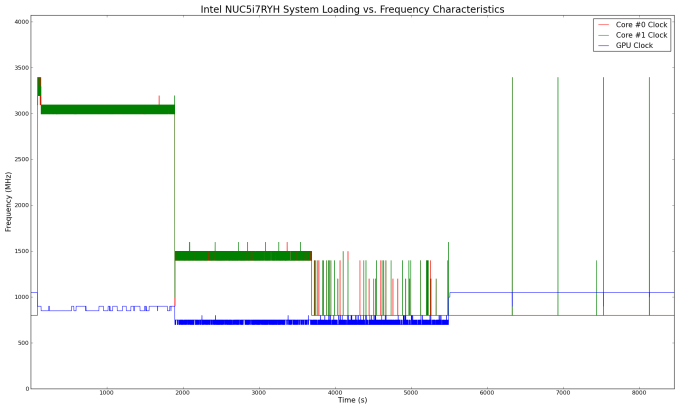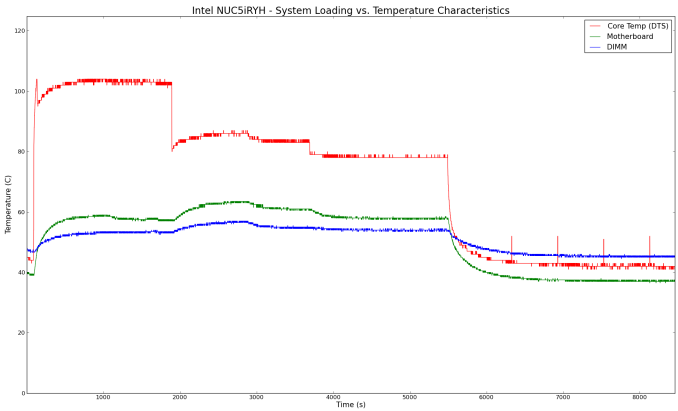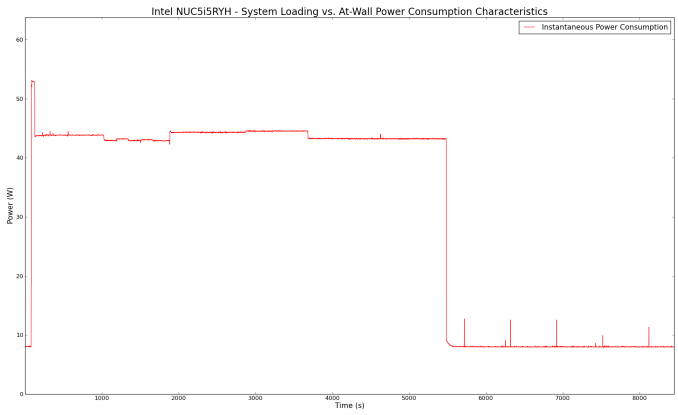Intel NUC5i7RYH Broadwell-U Iris NUC Review
by Ganesh T S on April 20, 2015 8:00 AM EST- Posted in
- Systems
- Intel
- HTPC
- NUC
- Broadwell-U
Power Consumption and Thermal Performance
The power consumption at the wall was measured with a 1080p display being driven through the HDMI port. In the graphs below, we compare the idle and load power of the Intel NUC5i7RYH with other low power PCs evaluated before. For load power consumption, we ran Furmark 1.12.0 and Prime95 v27.9 together. The numbers are not beyond the realm of reason for the combination of hardware components in the machine.


In the steady state, the clocks are managed in order to ensure that the at-wall power consumption stays within the limits of the thermal design's capabilities. As we will see further down, the unit can consume more than 55 W at the wall for short bursts before the thermal management kicks in.
Our thermal stress routine starts with the system at idle, followed by 30 minutes of pure CPU loading. This is followed by another 30 minutes of both CPU and GPU being loaded simultaneously. After this, the CPU load gets removed, allowing the GPU to be loaded alone for another 30 minutes. The various clocks in the system as well as the temperatures within the unit are presented below.
According to Intel's official specifications, the junction temperature of the Core i7-5557U is 105C. We find that pure CPU loading takes us close to it with turbo frequencies (3.4 GHz). However, before thermal throttling can kick in, the CPU cores revert to the rated operating frequency of 3.1 GHz. At that frequency, the cores have no trouble staying below the junction temperature.
The case of CPU and GPU getting loaded simultaneously is more interesting. The CPU cores run at 1.5 GHz and the GPU around 750 MHz. The temperature of the CPU package doesn't go above 85 C in this scenario. Obviously, we are not being thermally limited. The at-wall power consumption graph provides more insight.
The limiting factor on the performance / operating frequencies turns out to be the at-wall power consumption. With both CPU and GPU loaded simultaneously, the unit has a sustained power consumption of around 45 W, and we find that the number is similar for both the CPU-only and GPU-only scenarios.
On the whole the thermal design works well. As long as the limiting factors for the performance of the NUC are understood, the end users should not be in for any surprises.













66 Comments
View All Comments
Antronman - Tuesday, April 21, 2015 - link
Since when do monitors draw power from the device they're connected to anyways?eanazag - Tuesday, April 21, 2015 - link
Same response as close.Additionally, you want to have a power supply that can provide more juice because over time they lose the capacity to provide the highest specified wattage. If you have a device that routinely hits the max spec, you will experience some kind of failure. I'd rather see a 90 Watt charger. There were at least 3 USB slots I could see and they can pull at least 5 Watts. Additional components can pull more electricity too; like a 2.5 inch drive and the M.2 SSD. Maxed out the 65W adapter doesn't have a lot of wiggle room.
rhx123 - Monday, April 20, 2015 - link
I'm sure the NUCs are getting uglier each time. The all black Ivy Bridge NUC was by far the best looking of the lot.CaedenV - Monday, April 20, 2015 - link
So I am curious about 4K support. This thing purports to have 4K display support, but I wonder how well it works. In another year or two it will be time to upgrade my wife's desktop and I really want to get a slick little NUC (or NUC-like) device paired with a small-ish (35-45") curved 4K display/TV. All it needs to do is web browsing, office, UHD video (h.265, Netflix 4K and youtube 4K), and upscaling our digital library of our ripped DVDs and BluRays (h.264 and h.265) to 4K playback. It does not need to play games, or rather can stream games via the home network from the 'real computer' in the basement which should have 4K game support in a few years.Any thoughts if this is realistic on this model? Will the technology be there in this form factor in 2 years? Or should I be looking at one more home-built machine for my wife's desk? I would really like to get her something small and fanless... or at least low-power enough to run fanless most of the time.
ganeshts - Monday, April 20, 2015 - link
Something like the NUC will be working great in the next generation or so. This one has 4K support, but not HDMI 2.0 - Refer to our earlier piece on why most PC platforms are not ready for the 4K era yet : http://anandtech.com/show/9152/futureproofing-htpc...xchaotic - Tuesday, April 21, 2015 - link
'or rather can stream games via the home network' in uncompressed 4k???? that way more than even fiber can handleextide - Thursday, April 23, 2015 - link
He never said uncompressed 4k...PICman - Monday, April 20, 2015 - link
Ganesh, what is this 'realm of reason' of which you speak so frequently? What lies beyond the 'realm of reason'?nathanddrews - Monday, April 20, 2015 - link
Further confirmation that Broadwell is a big fizzle.Flunk - Monday, April 20, 2015 - link
Ticks generally just update the tock, so that's no surprise.